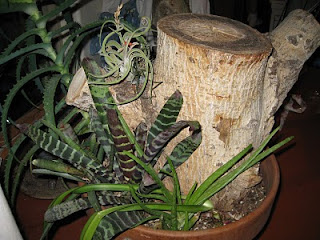
Okay, let’s say that you have followed my directions from previous posts and you selected the mushroom you wanted to grow and started growing a mushroom log. How do you take care of it? If you live in a humid climate that gets regular rain, that is actually pretty easy. Just put it on the north side of your house where it can catch the rain and rarely gets direct sun. Also, limit exposure to the ground to help keep out the bugs and other forms of contamination. Leaning it against the house or stacking on some cinder blocks works well for this.
If, like me, you live in an arid climate, or you want to keep the log inside, things get a little more tricky. You still want to protect the logs from the sun as much as you can, but you now have the added difficulty of keeping them wet normally. The first method is probably the easiest and works for all mushrooms that are happy growing from vertical surfaces. Get a pot that is slightly larger than the log and as tall as a third to a half of the log. Put in the log and fill it with either pasteurized wood chips or sand. Wood chips will give the log a little more nutrition, but you’ll have to inoculate them as well. I have actually inoculated the chips and let them inoculate the log and it has worked pretty well. From there, you just water the pot, pretty much like you would water a plant. Actually, more like you would water a cactus. Since the mushrooms are growing inside the log and have no leaves, they lose much less water to evaporation than plants. So watering them once a month or so is plenty. Another consideration is whether the pot has a drain in it or not. If you do have a drain, it can be difficult to get enough of the water to soak into the log. If you don’t have a drain, the water in the bottom can stagnate and get smelly. Personally, I prefer no drain, but I have done it both ways successfully.
If you want to up the stakes a little, you can make an ecosystem out of it. Once the mushrooms have had a month or two to work, I like to add a handful of worms to the wood chips and a few plants. The worms will break the wood chips down into a rich compost, which helps the plants grow. The plants will help pull water out of the bottom of the pot. They also make a nice indicator. If the plant is wilted, your mushroom probably also needs water. The plant and mushroom are also complimentary on gasses produced. The mushroom produces a slow, steady stream of carbon dioxide as it breaks down the log, which provides a perfect source of food for the plant. The plant provides a slow, steady supply of oxygen, which is perfect for the mushroom. It all makes for a lovely harmonious system, just like nature intended.
Another way of taking care of your log is to just mist it regularly. A regular, thorough misting will soak into the log and help keep it hydrated. Again, I tend to use plants to help with this process. Epiphytes are plants whose roots prefer to never touch soil, instead living up in trees. They aren’t parasites, though. They get all of their moisture from humidity and rain (or regular mistings in the home) and all of their nutrients come from the air. I particularly like epiphytes in the home because I figure (don’t really have any evidence, but it makes sense to me) that if they get all their nutrients from the air, they are probably pretty good at pulling all kinds of noxious gasses from the air. Most kinds of orchids, most kinds of bromeliads (especially tillandsias), and several kinds of ferns are all epiphytes. You can either glue them to your mushroom log or tie them down with wire. Since both orchids and bromeliads have beautiful flowers and often have wonderful forms, they actually make lovely arrangements, especially if you picked a log with branches to nestle the plants in. By regularly misting your plants, you are also regularly misting the log.
So, to recap, the only hard part about caring for a mushroom log is keeping it watered, but not too soggy. It really won’t have any visible signs of life, so you just need to remember to keep it happy until it is ready to produce fruit. I’ll talk about fruiting your log soon.


I can see that you are an expert at your field! I am launching a website soon, and your
ReplyDeleteinformation will be very useful for me.. Thanks for all your help and wishing you all the
success.